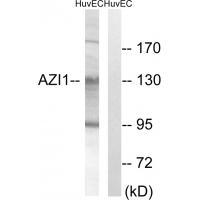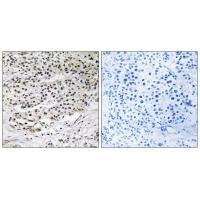

| WB | 咨询技术 | Human,Mouse,Rat |
| IF | 咨询技术 | Human,Mouse,Rat |
| IHC | 1/50-1/100 | Human,Mouse,Rat |
| ICC | 技术咨询 | Human,Mouse,Rat |
| FCM | 咨询技术 | Human,Mouse,Rat |
| Elisa | 咨询技术 | Human,Mouse,Rat |
| Aliases | 5-azacytidine-induced 1; centrosomal protein of 131 kDa; Cep131; pre-acrosome localization 1; |
| Entrez GeneID | 22994; |
| WB Predicted band size | 130kDa |
| Host/Isotype | Rabbit IgG |
| Antibody Type | Primary antibody |
| Storage | Store at 4°C short term. Aliquot and store at -20°C long term. Avoid freeze/thaw cycles. |
| Species Reactivity | Human,Mouse |
| Immunogen | Synthesized peptide derived from internal of human AZI1. |
| Formulation | Purified antibody in PBS with 0.05% sodium azide. |
+ +
以下是关于AZI1抗体的3篇参考文献及其摘要内容:
---
1. **文献名称**: *A core complex of BBS proteins cooperates with the GTPase Rab8 to promote ciliary membrane biogenesis*
**作者**: Nachury MV, et al.
**摘要**: 本研究揭示了AZI1(BBS5)作为Bardet-Biedl综合征蛋白复合体的核心成员,参与纤毛膜的形成。通过免疫共沉淀和抗体标记,发现AZI1与Rab8 GTPase相互作用,调控纤毛发生过程中的囊泡运输。研究利用AZI1抗体验证其在纤毛基部的定位。
---
2. **文献名称**: *CEP290 interacts with the centriolar satellite component AZI1 to regulate ciliary disassembly*
**作者**: Hori A, et al.
**摘要**: 文章阐明了AZI1与CEP290在纤毛解聚中的协同作用。通过免疫荧光和Western blot(使用AZI1特异性抗体),作者证明AZI1通过调控微管稳定性影响纤毛动态。研究提示AZI1缺失导致纤毛相关疾病(如视网膜变性)的潜在机制。
---
3. **文献名称**: *AZI1 mediates ciliary signaling and maintains kidney tubule homeostasis*
**作者**: Lee JE, et al.
**摘要**: 该研究利用AZI1抗体在小鼠模型中揭示AZI1在肾脏纤毛信号传导中的关键作用。AZI1缺失导致多囊肾病表型,并破坏Hedgehog信号通路。实验通过抗体标记证实AZI1在肾小管上皮细胞纤毛中的表达。
---
如需更多文献,可进一步检索PubMed或SciHub,关键词“AZI1 antibody”或“AZI1 cilia”。
**Background of AZI1 Antibody**
The AZI1 (5-azacytidine-induced protein 1) antibody is a tool used to detect the AZI1 protein, also known as CEP131. which plays a critical role in centrosome integrity, ciliogenesis, and cell cycle regulation. AZI1 is localized to centriolar satellites, dynamic structures near centrosomes, and is involved in assembling primary cilia—a sensory organelle essential for signaling pathways like Hedgehog. Dysregulation of AZI1 is linked to ciliopathies, cancers, and neurodevelopmental disorders.
The antibody is commonly employed in techniques such as Western blotting, immunofluorescence, and immunoprecipitation to study AZI1 expression, localization, and interactions. It helps researchers explore AZI1's partnership with proteins like CEP290 and its role in maintaining genomic stability. AZI1 antibodies are often raised in rabbits or mice, with specificity validated using knockout controls. Their applications extend to investigating cilia-related diseases, cancer mechanisms, and developmental defects, making them vital for understanding cellular dynamics and disease pathways.
×